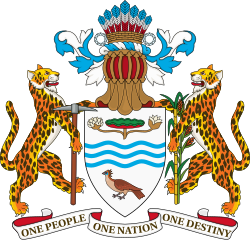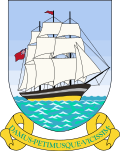Coat of arms of Guyana
| Coat of arms of Guyana | |
|---|---|
 | |
| Versions | |
 Coat of arms of the President | |
| Armiger | Co-operative Republic of Guyana |
| Adopted | 25 February 1966 |
| Crest | An Amerindian head-dress (also called a Cacique's Crown) with two diamond on the sides; a helmet Or; Mantling Azure and Argent |
| Torse | Azure and Argent |
| Blazon | Argent, three barrulets wavy Azure; in chief a Victoria regia lily, Guyana's national flower; in base the national bird, the Canje Pheasant (Opisthocomus hoazin) |
| Supporters | Jaguars with pick axe and stalks of rice and sugar cane |
| Motto | One People, One Nation, One Destiny |
The coat of arms of Guyana (Co-operative Republic of Guyana) was granted by the College of Arms on 25 February 1966.
It includes a crest of an Amerindian head-dress symbolizing the indigenous people of the country, this crest is also called the Cacique's Crown; two diamonds at the sides of the head-dress representing mining industry; a helmet; two jaguars as supporters holding a pick axe, sugar cane, and a stalk of rice (symbolizing Guyana's mining, sugar and rice industries); a shield decorated with the Victoria amazonica lily, Guyana's national flower; three blue wavy lines representing the three main rivers of Guyana; and the national bird, the Canje Pheasant (Opisthocomus hoazin). The national motto, "One people, One Nation, One Destiny", appears on the scroll below the shield.[1][2][3]
British Guiana[]
| Colony of British Guiana | ||
| Emblem | Period of use | Notes |
|---|---|---|

|
1875–1906 | Colonial badge of British Guiana, based on the seal of the Dutch West India Company. Depicting a sailing vessel with full sails. Before this the royal arms of the United Kingdom was used by the colonial authorities. |

|
1906–1955 | The badge remained the same but was further augmented with a golden strap surrounding the badge with the Latin motto "DAMUS PETIMUS QUE VICISSIM" (We Give and Demand Reciprocal). The design of the sailing ship was changed slightly. |

|
1955–1966 | On 8 December 1954 a coat arms was granted to the colony by the College of Arms in London. It depicted a Blackwall frigate in full sails, sailing to the sinister on waves of the sea, all proper. The same motto is written on a ribbon below the shield. Used until independence. |
Symbolism[]

The symbolism of the coat of arms of Guyana is as follows:[4]
- The Amerindian head-dress, the Cacique Crown, symbolises the Amerindians as the indigenous people of the country.
- The two diamonds at the sides of the head-dress represent the country’s mining industry.
- The helmet, on which the Cacique Crown rests, is the monarchical insignia.
- The two jaguars rampant, holding a pick-axe, a sugar cane, and a stalk of rice, symbolise labour and the two main agricultural industries of the country, sugar and rice.
- The shield, which is decorated with the national flower, the Victoria Regia Lily, is to protect the nation.
- The three blue wavy barrulets represent the three great rivers and many waters of Guyana.
- The Canje Pheasant at the bottom of the shield is a rare bird found principally in this part of the world and represents the rich fauna of Guyana.
See also[]
References[]
- ^ "The Coat of Arms". www.guyana.org. Retrieved 8 August 2017.
- ^ "NATIONAL SYMBOLS". www.guyana.org. Retrieved 8 August 2017.
- ^ "National Flag & Coat of Arms". www.caribcentral.com. Retrieved 8 August 2017.
- ^ https://www.constituteproject.org/constitution/Guyana_2016.pdf?lang=en[bare URL]
- National symbols of Guyana
- National coats of arms
- Coats of arms with crowns
- Coats of arms with pickaxes
- Coats of arms with sugarcane
- Coats of arms with rice
- Coats of arms with lilies
- Coats of arms with birds
- Coats of arms with animals
- National emblems with birds